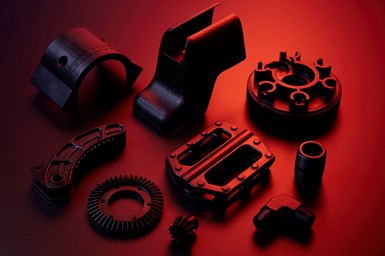Formlabs Resins for Creating Tough, Durable 3D Printed Parts
Company says new resins are high-performance polyurethane materials for additive manufacturing which are said to offer users more design freedom, reduced production costs and increased workflow efficiencies.

Rapid + TCT 2022: Parts made with PU Rigid 650 Resin and PU Rigid 1000 Resin. Photo Credit: Formlabs
Formlabs has added PU Rigid 650 Resin and PU Rigid 1000 Resin to its line of 3D printing materials which are available for use on the company’s Form 2, Form 3, Form 3+, Form 3B and Form 3B+ stereolithography (SLA) printers.
These high-performance polyurethane materials are well suited for producing rigid and durable parts, and are the toughest materials to be added to Formlabs’ SLA ecosystem, the company says. Both materials are said to enable users to break free of the limitations of traditional polyurethane manufacturing by offering more design freedom, reduced production costs and increased workflow efficiencies.
It is said the PU Rigid 650 Resin can be used to produce impact-resistant and pliable parts that can maintain dimensional accuracy under load, while PU Rigid 1000 Resin can be used to produce semi-stiff, sturdy and unyielding parts that repeatedly endure high stress environments.
The resins are designed to build upon the existing capabilities of Formlabs’ SLA printers to provide users with the ability to produce polyurethane parts that can withstand extreme manufacturing environments and design requirements. Both materials can be utilized across various industries such as manufacturing, medical, automotive, aerospace, industrial and consumer.
Applications for PU Rigid 650 Resin include high-performance connectors such as hinges and snap fits, and impact-resistant components such as wheels, bumpers and grommets. PU Rigid 1000 Resin is best used to create jigs and fixtures, castings and enclosures, and sturdy consumer products such as bottle caps, buckles and bike pedals.
Related Content
-
Copper, New Metal Printing Processes, Upgrades Based on Software and More from Formnext 2023: AM Radio #46
Formnext 2023 showed that additive manufacturing may be maturing, but it is certainly not stagnant. In this episode, we dive into observations around technology enhancements, new processes and materials, robots, sustainability and more trends from the show.
-
Concept Sneaker Boasts One-Piece 3D Printed TPU Construction
The Reebok x Botter Concept Sneaker Engineered by HP premiered at Paris Fashion Week, hinting at manufacturing possibilities for the future of footwear.
-
Q&A With Align EVP: Why the Invisalign Manufacturer Acquired Cubicure, and the Future of Personalized Orthodontics
Align Technology produces nearly 1 million unique aligner parts per day. Its acquisition of technology supplier Cubicure in January supports demand for 3D printed tooling and direct printed orthodontic devices at mass scale.











